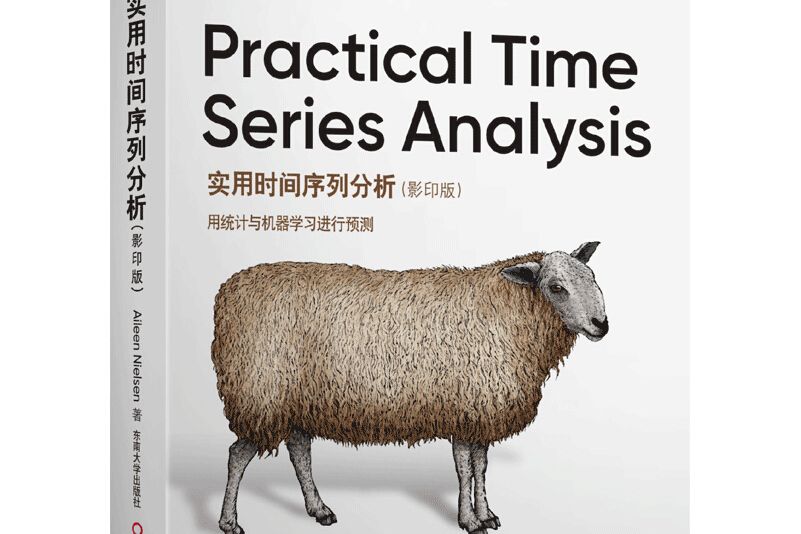內容簡介
隨著物聯網、數字醫療、智慧城市的興起,時間序列數據分析變得越來越重要。隨著持續監測和數據收集變得越來越普遍,對通過統計和機器學習技術進行時間序列分析的需求將會增長。
《實用時間序列分析(影印版)》涵蓋了時間序列數據分析的創新成果和現實世界的案例,使用傳統統計方法和現代機器學習技術,幫你應對時間序列中常見的數據工程和分析挑戰。作者Aileen Nielsen用R和Python語言對時間序列進行了全面且通俗易懂的介紹,數據科學家、軟體工程師和研究人員都可以很快上手並投入使用。
圖書目錄
Preface
1.TimeSeries:AnOverviewand aQuickHistory
The History of Time Series in Diverse Applications
Medicine as a Time Series Problem
Forecasting Weather
Forecasting Economic Growth
Astronomy
Time Series Analysis Takes Off
The Origins of Statistical Time Series Analysis
The Origins of Machine Learning Time Series Analysis
More Resources
2.FindingandWranglingTimeSeriesData
where to Find Time Series Data
Prepared Data Sets
Found Time Series
Retrofitting a Time Series Data Collection from a Collection of Tables
A Worked Example:Assembling a Time Series Data Collection
Constructing a Found Time Series
Timestamping Troubles
Whose Timestamp
Guesstimating Timestamps to Make Sense of Data
What’s a Meaningful Time Scale
Cleaning Your Data
Handling Missing Data
Upsampling and Downsampling
Smoothing Data
Seasonal Data
Time Zones
Preventing Lookahead
More Resources
3.ExploratoryDataAnalysisforTimeSeries
Familiar Methods
Plotting
Histograms
Scatter Plots
Time Series-Specific Exploratory Methods
Understanding Stationarity
Applying Window Functions
Understanding and Identifying Self-Correlation
Spurious Correlations
Some Useful Visualizations
lD Visualizations
2D Visualizations
3D Visualizations
More Resources
4.SimulatingTimeSeriesData
What’S Special About Simulating Time Series
Simulation Versus Forecasting
Simulations in Code
Doing the Work Yourself
Building a Simulation Universe That Runs Itself
A Physics Simulation
Final Notes on Simulations
Statistical Simulations
Deep Learning Simulations
More Resources
5.StoringTemporalData
Defining Requirements
Live Data Versus Stored Data
Database Solutions
SQL Versus NoSQL
Popular Time Series Database and File Solutions
File Solutions
NumPv
Pandas
Standard R Equivalents
Xarray
More Resources
6.StatisticaIModelsforTimeSeries
Why Not Use a Linear Regression
Statistical Methods Developed for Time Series
Autoregressive Models
Moving Average Models
Autoregressive Integrated Moving Average Models
Vector Autoregression
Variations on Statistical Models
Advantages and Disadvantages of Statistical Methods for Time Series
More Resources
7.StateSpaceModels for TimeSeries
State Space Models:Pluses and Minuses
The Kalman Filter
Overview
CodefortheKalmanFilter、
Hidden Markov Modds
HOW the Model Works
HOWWeFittheModel
Fitting an HMM in Code
Bayesian Structural Time Series
Code forbsts
More Resources
8.Generating and Selecting FeaturesforaTimeSeries
Introductory Example
General Considerations When Computing Features
The Nature of the Time Series
Domain Knowledge
External Considerations
A Catalog of Places to Find Features for Inspiration
Open Source Time Series Feature Generation Libraries
Domain-Specific Feature Examples
How to Select Features 0nce You Have Generated Them
Concluding Thoughts
More Resources
9.Machine LearningforTime Series
Time Series C:lassification
Selecting and Generating Features
Decision Tree Methods
Clustering
Generating Features from the Data
TemporaUy Aware Distance Metrics
Clustering Code
More Resources
10.Deep LearningforTimeSeries
Deep Learning Concepts
Programming a Neural Network
Data,Symbols,Operations,Layers,and Graphs
Building a Training Pipeline
Inspecting Our Data Set
Steps of a Training Pipeline
Feed Forward Networks
A Simple Example
Using an Attention Mechanism to Make Feed Forward
Networks More Time—Aware
CNNS
A Simple Convolutional Model
Alternative Convolutional Models
RNNS
Continuing Our Electric Example
The Autoencoder Innovation
Combination Architectures
Summing Up
More Resources
11.Measuring Error
The Basics:HoW to Test Forecasts
Model-Specific Considerations for Backtesting
When Is Your Forecast Good Enough
Estimating Uncertainty in Your Model with a Simulation
Predicting Multiple Steps Ahead
Fit Directlv to the Horizon of Interest
Recursive Approach to Distant Temporal Horizons
Multitask Learning Applied to Time Series
Model Validation Gotchas
More Resources
1 2.Performance Considerations in Fitting and Serving Time Series Models
Working with Tools Built for More General Use Cases
Models Built for Cross.Sectional Data Don't Share”Data Across Samples
Models That Don’t Precompute Create Unnecessary Lag Between
Measuring Data and Making a Forecast
Data Storage Formats:Pluses and Minuses
Store Your Data in a Binary Format
Preprocess Your Data in a Way That Allows Yon to“Slide”Over It
Modi研ng Your Analysis to Suit Performance Considerations
Using A11 Your Data Is Not Necessarily Better
Complicated Models Don’t Always Do Better Enough
A Brief Mention of Alternative High—Performance Tools
More Resources
13.HealthcareApplications
Predicting the Flu
A Case Study of Flu in 0ne Metropolitan Area
What Is State of the Art in Flu Forecasting
Predicting Blood Glucose Levels
Data Cleaning and Exploration
Generating Features
Fitting a Model
More Resources
14.FinanciaIApplications
Obtaining and Exploring Financial Data
Preprocessing Financial Data for Deep Learning
Adding Quantities of Interest to Our Raw Values
Scaling Quantities of Interest Without a Lookahead
Formatting 0ur Data for a Neural Network
Building and Training an RNN
More Resources
15.TimeSeriesforGovernment
Obtaining Governmental Data
Exploring Big Time Series Data
Upsample and Aggregate the Data as We Iterate Through It
Sort the Data
0nline Statistical Analysis of Time Series Data
Remaining Questions
Further Improvements
More Resources
16.TimeSeriesPackages
Forecasting at Scale
Google’S Industrial In.house Forecasting
Facebook’S Open Source Prophet Package
Anomaly Detection
Twitter’s Open Source AnomalyDetection Package
Other Time Series Packages
More Resources
17.ForecastsAbout Forecasting
Forecasting as a Service
Deep Learning Enhances Probabilistic Possibilities
Increasing Importance of Machine Learning Rather Than Statistics
Increasing Combination of Statistical and Machine Learning Methodologies
More Forecasts for Everyday Life
Index
作者簡介
艾琳·尼爾森(Aileen Nielsen),是一名為紐約市服務的軟體工程師和數據分析師。從醫療創業到政治競選,從物理研究實驗室到金融交易公司,她在多個領域從事時間序列研究。她目前正在開發用於預測套用的神經網路。

